In the realm of music, a guitar chord progression serves as the backbone of any song.
It dictates the harmony, provides structure, and sets the emotional tone of a composition.
A well-crafted chord progression can turn even the simplest melody into a riveting musical piece.
Understanding and mastering progressions is a key aspect of successful songwriting and taking your music to new heights.
This blog post provides an extensive examination of guitar chord progressions; their fundamental elements, their importance, and most importantly, how to utilize them effectively in your compositions.
It’s perfect for songwriters, composers, guitar enthusiasts or anyone keen to enhance their musicality.
Table of Contents
Guitar Chord Progressions
vi-iv-I-V (6-4-1-5)
A timeless progression delivering uplifting vibes and nostalgic emotion.
The vi-iv-I-V chord progression is a classic structure in popular music, offering a lightly melancholic start with the minor vi chord before resolving to a triumphant I and V end. The easy transition and melodic fluidity of this progression cater to many genres and moods, effectively invigorating your music with a nostalgic, yet uplifting tone.
- Difficulty: Easy
- Example: F#m – Dm – A – E (Key of A major)
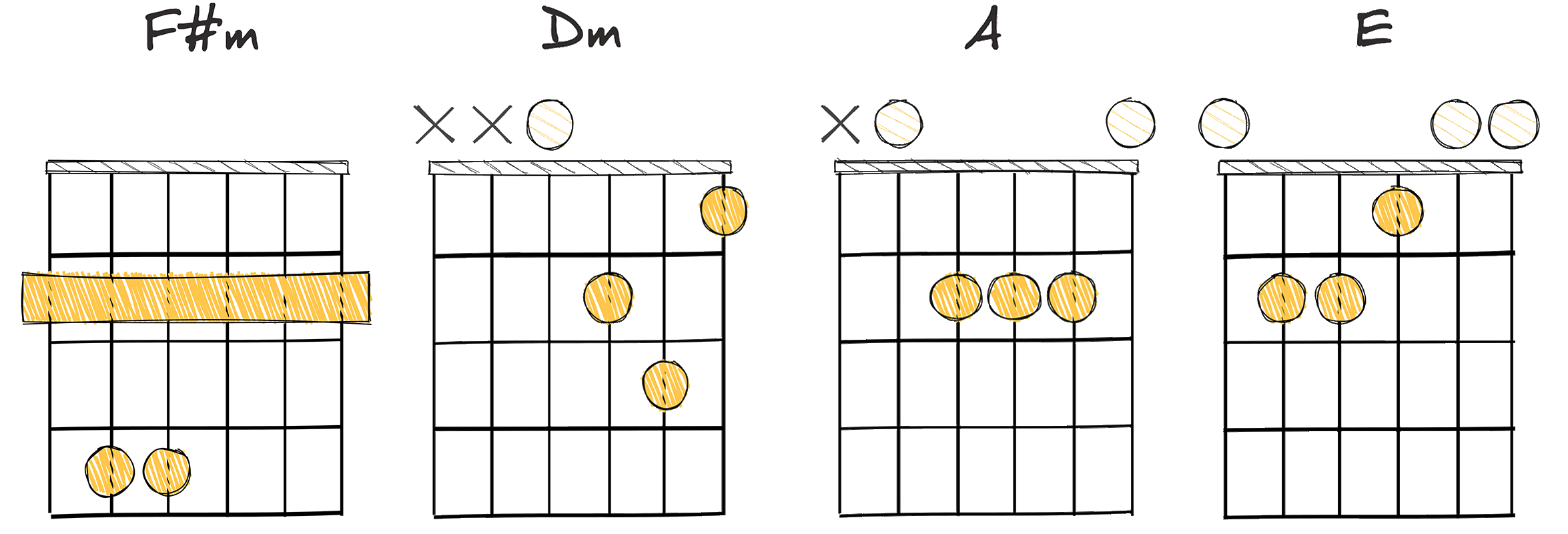
Chord progression 6 on our list is the vi-iv-I-V (6-4-1-5) progression.
Being ubiquitous in pop music, this is a progression that has history deeply embedded into it, shaping songs and creating memorable musical moments.
Historically, the vi-iv-I-V progression first gained popularity in the late 1950s, cementing itself as a cornerstone in memorable melodies across various genres.
Notably, the vi-iv-I-V progression is also relatively easy to play which makes it a favored choice among beginner guitarists and seasoned professionals alike.
Due to its simplistic structure, guitarists can quickly grasp the framework and experiment with their own artistic expression.
The vi-iv-I-V chord progression also lends itself well to a variety of strumming patterns, thus allowing guitarists to experiment and add their own personal touches.
Moreover, the progression’s smooth transition between chords provides an easy flow and a stable harmonic foundation.
This allows melody lines to weave in and out with ease, creating a compelling sonic landscape.
The strength of the vi-iv-I-V chord progression really comes to light when we consider the emotional depth it can create.
Songs using this progression often convey a poignant mix of hope, nostalgia, and longing.
Although the vi-iv-I-V chord progression is commonly found in pop music, it is by no means confined to this genre.
Its beauty and flexibility allow it to be utilized across a variety of musical styles, from rock to country, blues and beyond.
I-IV-V-I (1-4-5-1)
The classic, uplifting resolution for rock and blues melodies.
The I-IV-V-I chord progression is a classic and fundamental sequence in music theory, notably in blues, rock, and pop genres. It offers a simple yet dynamic sound that serves as the backbone to countless songs, allowing for both melodic predictability and various improvisation possibilities.
- Difficulty: Easy
- Example: G – C – D – G (Key of G major)
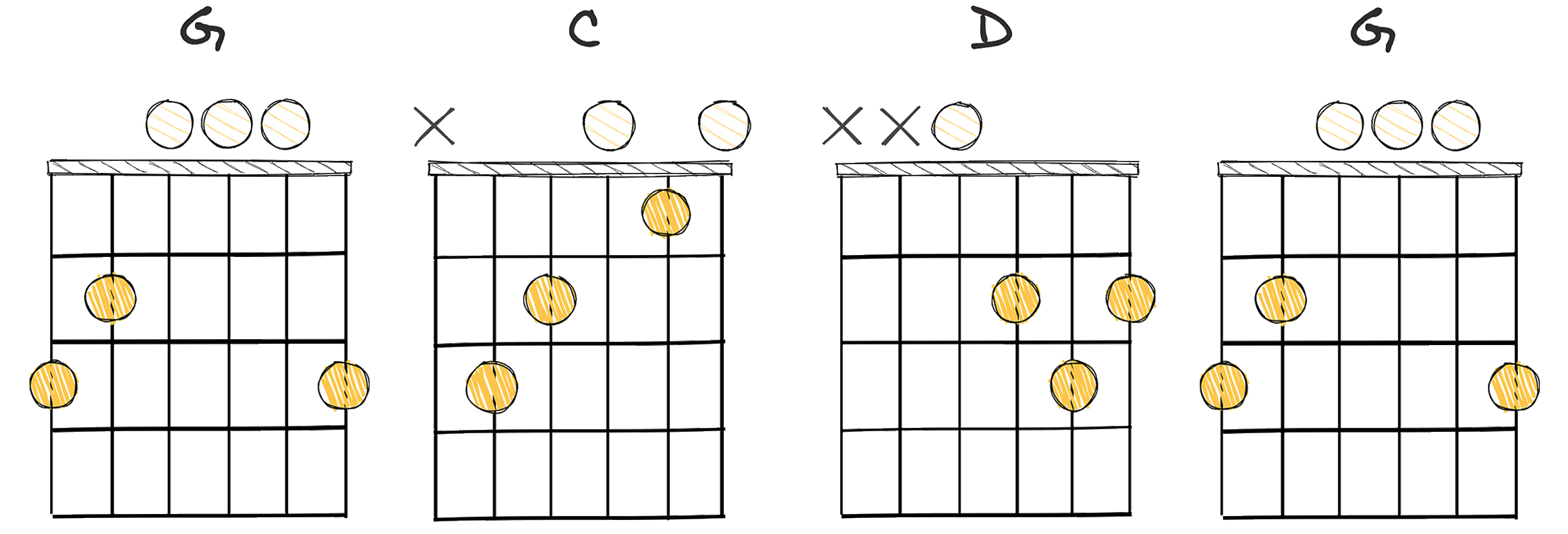
The I-IV-V-I chord progression has a rich and engaging history that seamlessly traverses different music genres.
Also known as the 1-4-5-1 in Nashville number system, this chord progression is a favorite for many musicians due to its fascinating melodic structure.
This progression maintains a balanced harmonic movement, which creates perfect cadences and a cyclical effect at the end, which is the primary reason for its prominence.
It allows the piece of music to return to the tonic or root note, producing a satisfying feeling of musical completeness.
Being favored by many musicians is not by chance – the I-IV-V-I chord progression is relatively easy to play, hence seen as a magic path for beginners.
Nonetheless, the simplicity of this chord progression should not overshadow its capacity to produce beautiful and melodious songs.
Even seasoned musicians often resort to it to create catchy and diverse musical textures.
It is worth noting that the progression is not restricted to major keys only.
In fact, you can use this versatile progression with minor keys to create a different mood altogether.
This way, the I-IV-V-I progression serves as an all-rounded chord progression that’s flexible for various applications.
Therefore, the I-IV-V-I chord progression is more than just a simple sequence of chords.
In reality, it’s a musical journey that allows composers and listeners alike to experience diverse auditory aspects, from the basic melodic structure to the progression’s harmonious completeness.
ii-V-I (2-5-1)
An iconic progression, ii-V-I breathes versatile harmony into compositions.
The ii-V-I progression is one of the most popular chord progressions in music, particularly in jazz. Its beauty lies in the strong tonal movement that creates tension and resolution, making it an impactful tool for songwriters and musicians to create diverse musical landscapes.
- Difficulty: Intermediate
- Example: Dm – G – C (Key of C major)
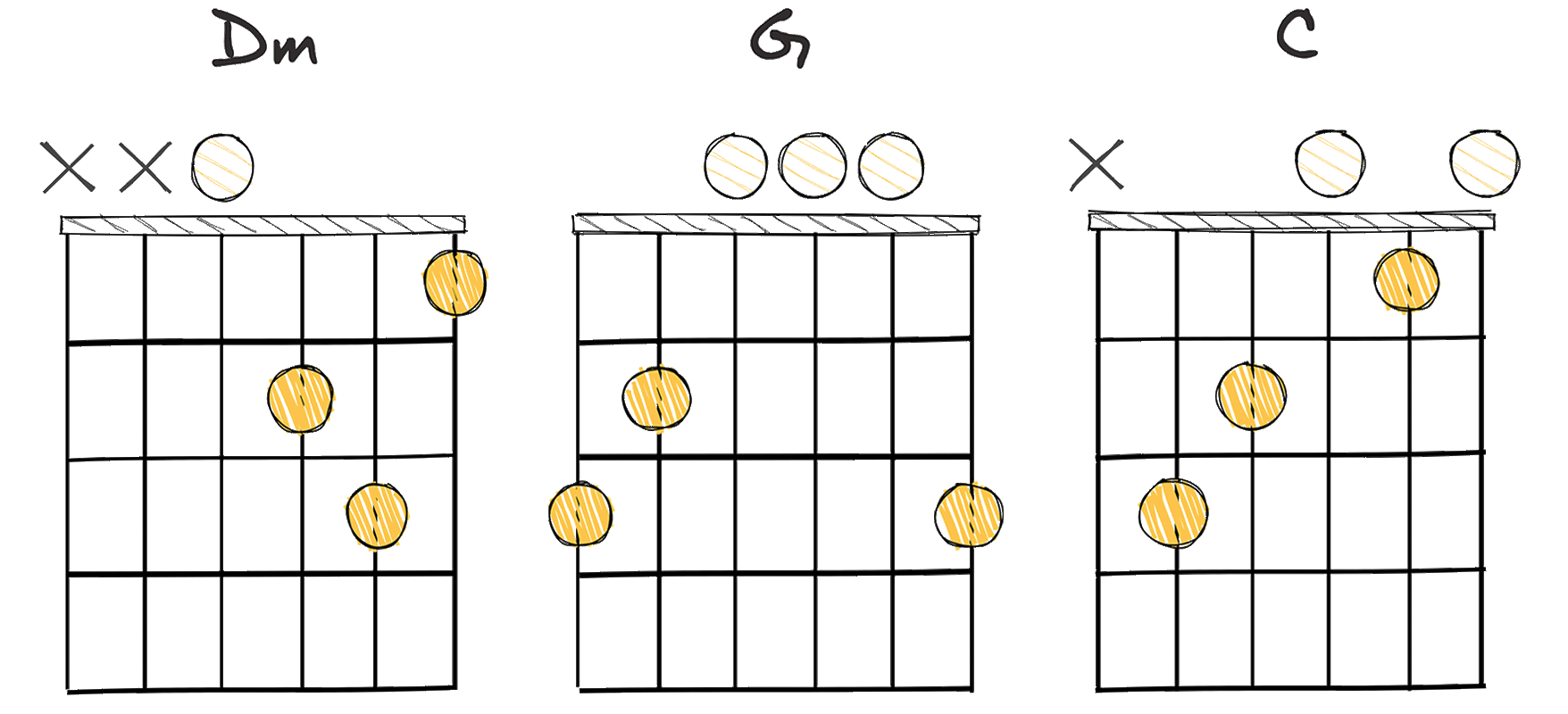
The ii-V-I (2-5-1) progression is not merely a staple of jazz, but a defining part of its history and sound.
This chord progression, which originated in the Jazz era, is considered an intermediate level progression for most guitar players due to its technical and theoretical complexity.
Throughout history, the ii-V-I progression has demonstrated its versatility and adaptability across a range of musical genres.
This progression, which heavily relies on tension and release, sets the stage for a plethora of harmonic possibilities.
Playing over a ii-V-I chord progression poses a unique challenge, requiring a deep understanding of both chord voicings and improvisational concepts.
The ii-V-I progression requires guitarists to navigate complex harmony efficiently and melodically, which is a hall mark of competent and skilled musicianship.
This is undoubtedly why so many advanced guitarists and composers in history have gravitated toward this chord progression.
The techniques and skills required to master the ii-V-I progression can take years of dedicated practice and study.
Nevertheless, the reward for such dedication is a profound ability to express oneself musically with depth and sophistication.
The ii-V-I chord progression may be complex, but that’s part of why it’s so rewarding to learn and implement.
It is absolutely a chord progression that can elevate one’s music, regardless of the style or genre.
So whether you’re writing an emotional ballad or a swinging jazz tune, the ii-V-I chord progression could be the tool that elevates your songs to the next level.
ii-V-I-IV (2-5-1-4)
Harness the ii-V-I-IV progression for transcending musical boundaries.
The ii-V-I-IV chord progression is a classic sequence typically found in jazz music, often used due to its resonant and harmonious flow. This progression inherently creates a sense of resolution and closure making it ideal for ending musical phrases, thus enhancing the overall narrative of your song.
- Difficulty: Intermediate
- Example: Dm – G – C – F (Key of C major)
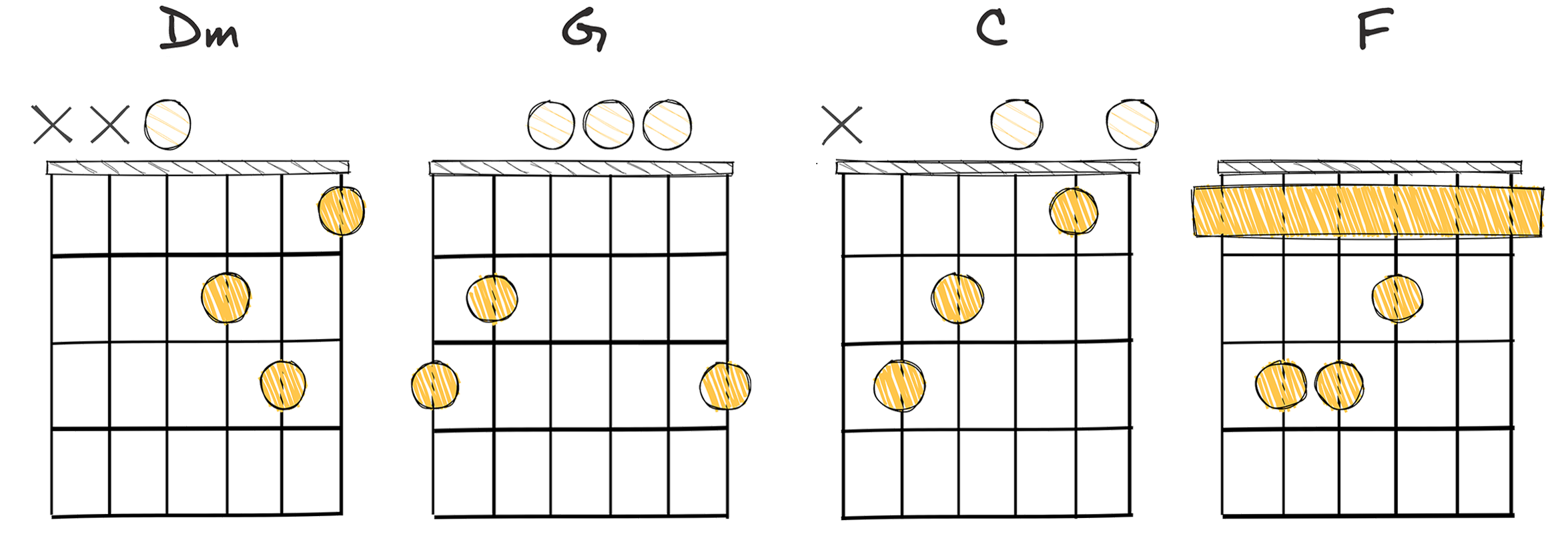
When examining guitar chord progressions that significantly improve the sound of your music, the ii-V-I-IV (2-5-1-4) progression is an important feature to consider.
This chord progression is of intermediate difficulty, so its incorporation demands a fair amount of practice, but the resulting sound is worth the effort.
The ii-V-I-IV progression essentially has roots in jazz and classical music, but it has been widely used and adapted into other genres.
It’s a chord progression marked by the organized, cyclical progression of tension and resolution, which provides a dramatic yet smooth harmonic context.
You see, chord progressions are more than just a series of chords placed together – they convey mood, drive the melody, and shape the emotional structure of a song.
The ii-V-I-IV progression provides the chordal structure of a song but also provides an interesting journey of tension and release, which is the essence of beautiful music.
The emotionally resonant sounds are intrinsically connected to the sequence of chords that have been selected and their corresponding effects on the tonal structure of the music.
It’s this unique ability of the ii-V-I-IV progression to imbue every piece of music with a sense of tonal dynamism and emotional richness that makes it so effective.
Admittedly, ii-V-I-IV progression requires a measure of skill and practice for those who are at the intermediate level of learning the guitar.
However, the challenge it presents is what makes perfecting this progression so rewarding.
I-V-vi-IV (1-5-6-4)
Emotion-evoking progression, a staple in pop and rock anthems.
The I-V-vi-IV progression is a classic and universally used sequence in the world of music, known for its melancholic yet compelling sound. This progression alternates between major and minor chords, offering a mix of uplifting and gloomy moods, thus giving a lot of depth and emotionality to the compositions.
- Difficulty: Easy
- Example: G – D – Em – C (Key of G major)
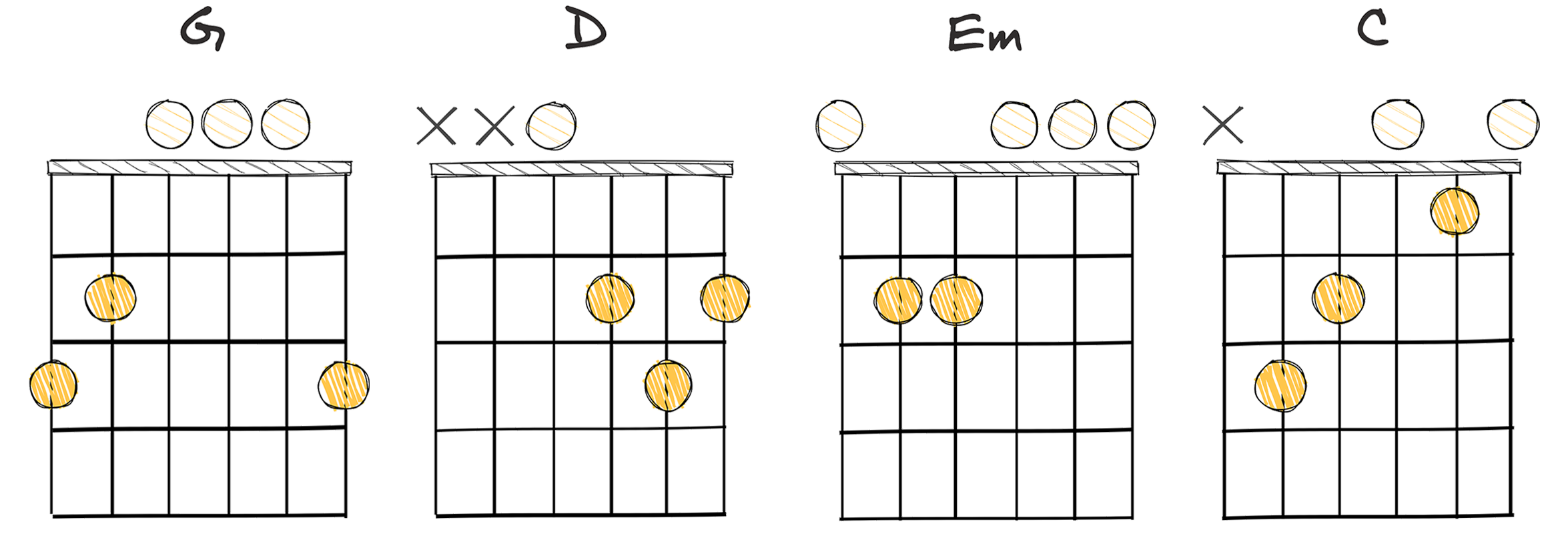
The I-V-vi-IV (1-5-6-4) chord progression is one of the most widely recognized and utilized progressions in the pantheon of guitar music.
Steeped in a rich history, this progression has been favored by musicians for its simplicity and versatility.
Regardless of whether the genre is rock, pop, or country, you’ll find countless songs powered by the iconic I-V-vi-IV sequence.
Also known as the “pop-punk progression” due to its widespread use in pop and punk music, I-V-vi-IV provides a straightforward yet compelling harmonic backbone for songwriting.
Building on the emphasis of this progression found on pop and punk music, this chord pattern’s musical attraction comes from its ability to simultaneously create tension and resolution.
That said, the chord progression is not restricted to a specific genre of music, it is a staple across various music styles.
While the I-V-vi-IV progression may seem basic, its effectiveness lies in its simplicity.
The I-V-vi-IV progression is not just an amateur’s tool—it’s user-friendly nature makes it easy to play for beginners, but its potential for endless variations keeps it interesting for experienced musicians as well.
Despite its apparent simplicity, the I-V-vi-IV progression can yield a wide range of emotional tones based on how the chords are played.
In the key of G major, for instance, the chords in this sequence would be G – D – Em – C.
This progression’s iconic sound has led to its overuse in some circles resulting in it being the subject of satire.
However, its continued usage by artists at the forefront of their genres demonstrates the progression’s enduring versatility and impact.
I-V-vi-IV’s dominant presence in popular music speaks to its inherent appeal to both listeners and musicians.
I-IV-V (1-4-5)
The backbone of countless hits, I-IV-V brings a timeless appeal.
The I-IV-V chord progression is a fundamental sequence in music, particularly prevalent in blues, pop, and rock genres. These tonal centers define the harmonic structure of the piece and carry a sense of inevitability and resolution, making the progression both satisfying and emotionally resonant for listeners.
- Difficulty: Easy
- Example: G – C – D (Key of G major)
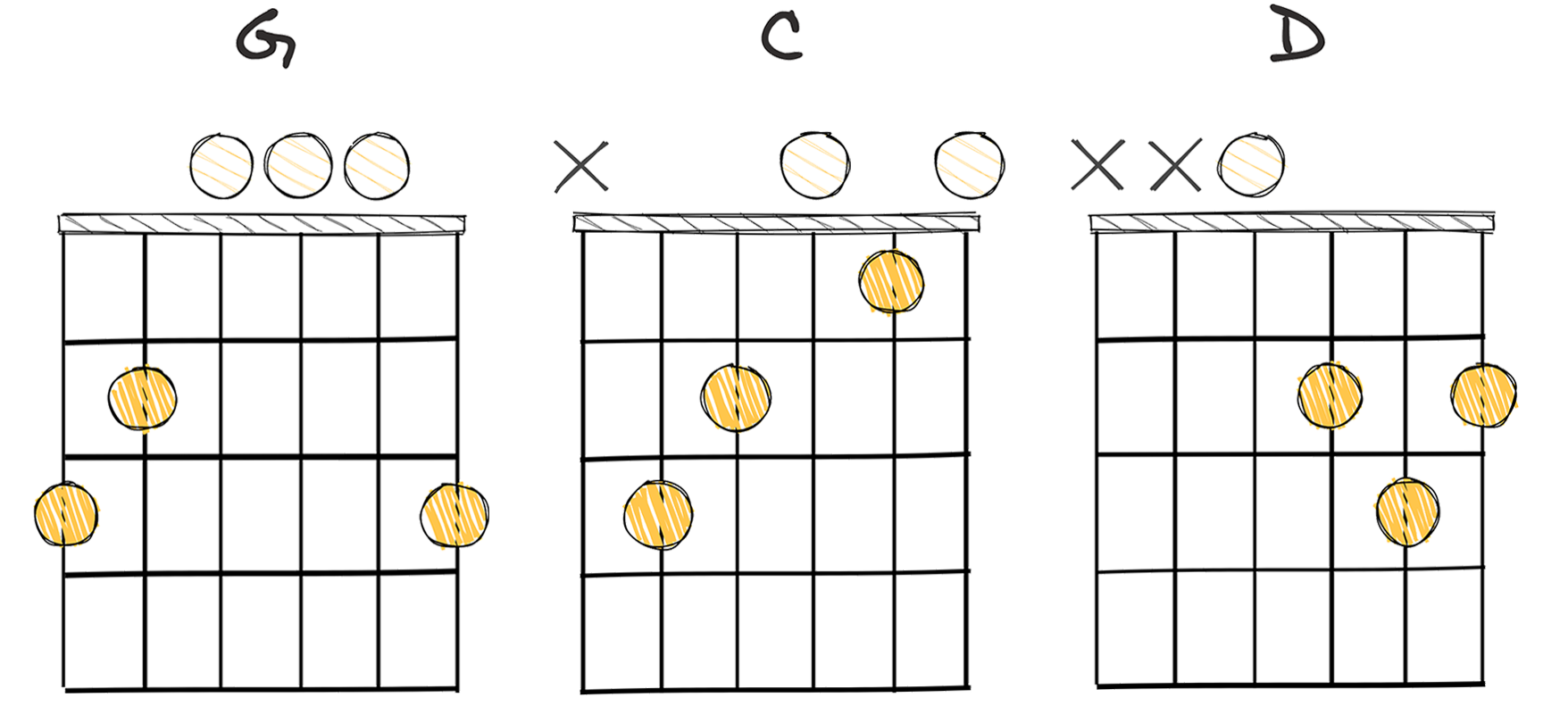
When it comes to guitar chord progressions, one of the most common and easy to play is the I-IV-V (1-4-5) progression.
This simple but effective chord progression has its roots in blues and rock ‘n’ roll music, and has been widely used across many music genres due to its ability to create a pleasing, resolved sound.
The I-IV-V progression is a foundational piece in the history of guitar music, contributing to the vast majority of chart-topping hits over several decades.
Supporting the significance of this progression, it is impossible to overstate its influence on popular music.
From the bluesmen of the early 20th century to the rock and pop artists of today, countless musicians have used this tried-and-true progression to write timeless songs.
What makes the I-IV-V progression particularly appealing is that it can be used in varying musical contexts, making it extremely versatile.
It can be played in any musical key, allowing musicians to adapt it to their own style and vocal range.
One important point to note is that while this progression is easy to play, it also offers a lot of room for variations and creativity, making it a great choice for musicians at any skill level.
The simple structure of the I-IV-V progression makes it a great starting point for enhancing musical compositions, providing a platform for both learning and creativity.
Understanding its structure and application can help inform one’s musical choices, ultimately leading to more compelling songwriting.
I-vi-IV-V (1-6-4-5)
Discover the heartbeat of many classic pop and rock songs.
The I-vi-IV-V progression is a popular and timeless sequence in guitar music, instantly recognizable and incredibly versatile. Often used in pop and rock genres, it is known for creating a catchy melody that gravitates back to the root key while allowing ample room for creative exploration.
- Difficulty: Easy
- Example: G – Em – C – D (Key of G major)
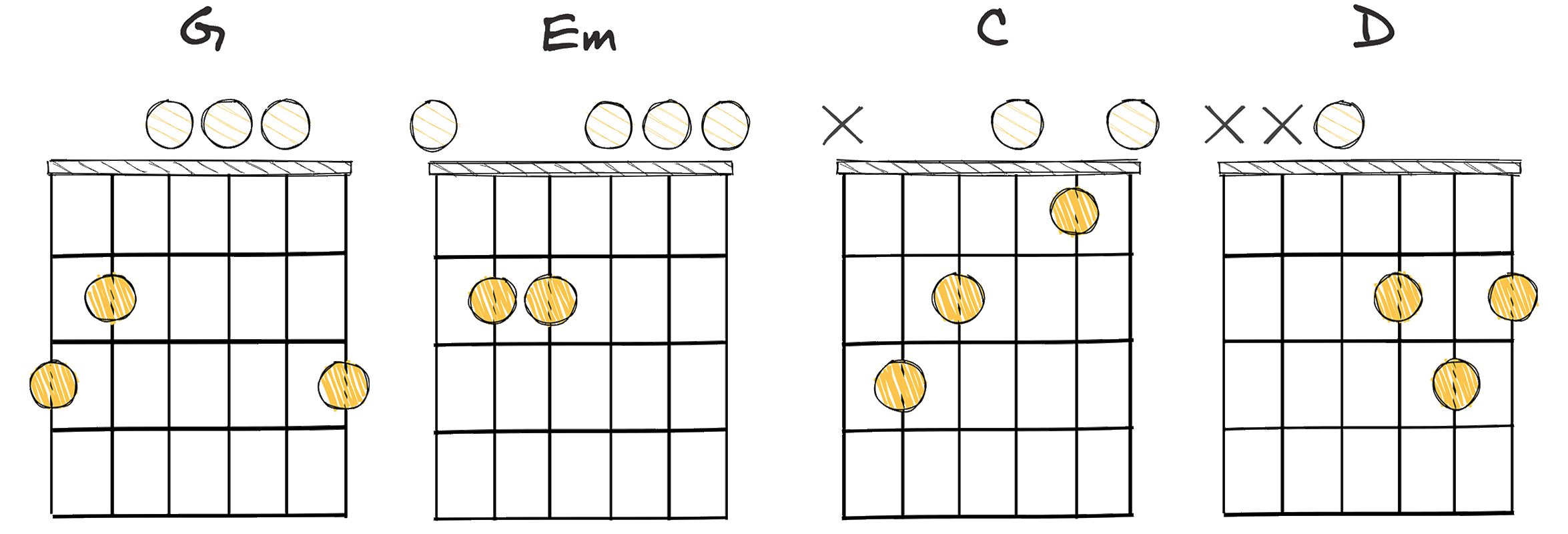
The I-vi-IV-V (1-6-4-5) chord progression is a classic go-to sequence that has been used numerous times across different musical eras.
Also known as the 50s progression, it carries a trademark, nostalgic charm that allows many musicians to channel the golden age of music.
When it comes to the instrument this progression is played on and its ease of execution, the guitar is often the preferred choice.
Strumming the I-vi-IV-V chord pattern is somewhat methodical and straightforward for guitarists, making it easy to play for both beginners and professionals alike.
Even though it is known as the ’50s progression, the I-vi-IV-V chord sequence has a historical precedence that extends far beyond that era, tracing back to classical compositions and baroque period’s music.
This can be attributed to the progression’s ability to beautifully transition between great tension and release, creating an inviting and attractive harmonic movement that appeals to our intrinsic human desire for balance and resolution.
Despite its far-reaching musical roots, this great sequence is principally associated with the 1950s era, when it was frequently integrated into the genre of doo-wop, and later evolved to be a much-used sequence in pop and rock genres.
The I-vi-IV-V progression has a distinct quality within its simplicity.
The simplicity of its structure and ease of execution has led it to be a staple for musicians in creating an array of emotional moods and storytelling modes.
The first chord, representing the tonic or ‘home’ chord ‘I,’ sets a stable, grounding footing.
The second chord, ‘vi’, is a minor, which switches the mood to a somber, reflective tone.
The ‘IV’ chord breaking up the tension and providing an impression of uplifting the spirit.
The ‘V’ chord, resolving back to ‘I’, gives that ultimate relief and satisfying conclusion.
Thus, with the I-vi-IV-V progression, you can lead your listeners through an emotional roller coaster, from happiness to sadness and back to resolution, all within a simple, 4-chord pattern.
Whether you’re a seasoned songwriter or a new musician exploring the world of chord progressions, the I-vi-IV-V progression presents an easy-to-learn, enriching and undeniably timeless tool for creating memorable, evocative music.
I-IV-ii-V (1-4-2-5)
An irresistible progression unlocking rich, harmonic landscapes in your compositions.
The I-IV-ii-V chord progression, also known as 1-4-2-5, is a foundational sequence in many genres, offering a smooth, balanced transition between chords. It is an adaptable and melodious progression that creates a pleasing motion in music, enhancing the overall quality and emotional resonance of any piece.
- Difficulty: Intermediate
- Example: D – G – Em – A (Key of D major)
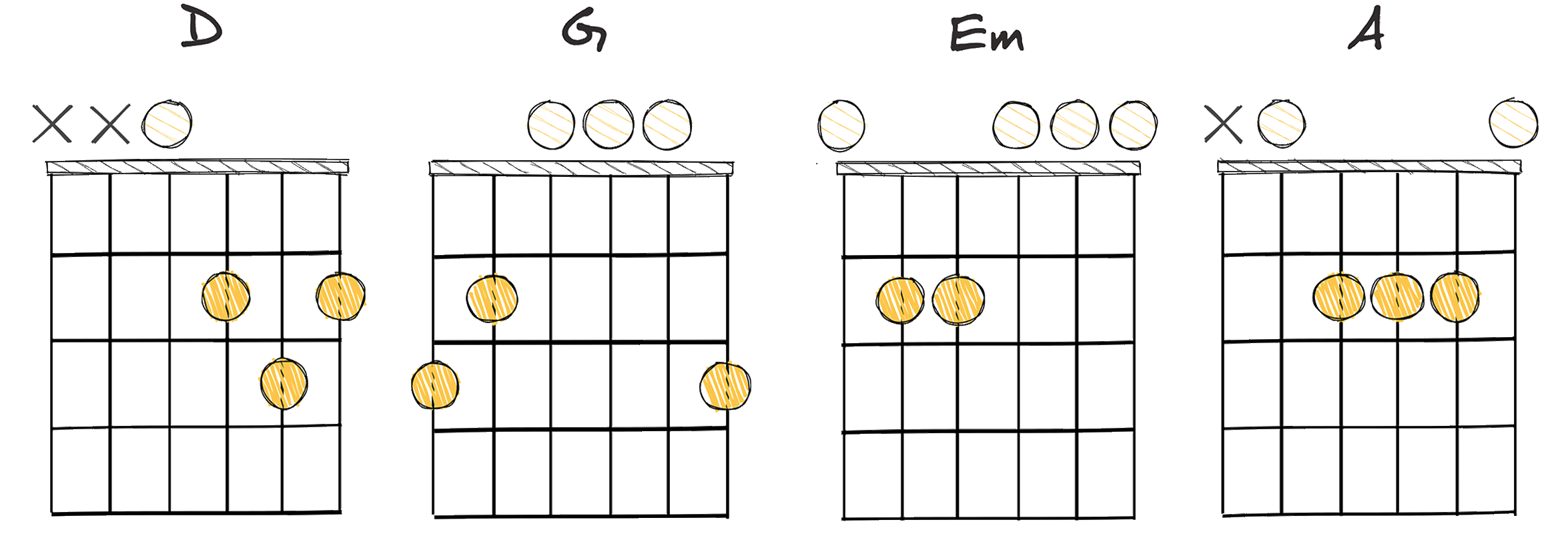
One guitar chord progression that can significantly elevate your music is the I-IV-ii-V progression, also known as the 1-4-2-5 chord progression in the key of D Major, for example.
This progression is considered intermediate in terms of complexity, requiring a certain level of guitar proficiency to execute smoothly.
The I-IV-ii-V progression has a rich history within the world of music, particularly in genres such as jazz, blues, rock and pop.
The chord progression can be traced back to the Baroque period, and continues to be a staple in many modern music compositions today.
Specifically in the Key of D Major, the I-IV-ii-V progression is characterized by the chords D – G – Em – A.
Not only does it serve as a harmonious bridge between chord sequences, but it also enhances the overall musical journey listeners embark on.
Remember, the ii-V part of this progression is intriguing because it moves from a minor chord to a dominant seventh chord, a combination that makes for an engaging sound.
It is this unique sequence of chords that gives the I-IV-ii-V progression its enduring appeal in music composition.
Many songwriters and composers find this progression to be an adaptable and dynamic tool when weaving their musical tapestry.
To sum it up, the I-IV-ii-V progression is not only historically significant but also possesses an impressive range of musical applications in modern music composition.
Truly, whether you’re a songwriter or a performer, utilizing this chord progression can definitely take your music to new heights.
I-V-vi-iii-IV (1-5-6-3-4)
This progression balances resolution and suspense, enhancing musical storytelling.
This chord progression is incredibly popular in many genres of music and adds a depth of emotion to your playing. Starting with a strong, stable foundation on the I chord, it then moves to the dominant V, melancholic vi, mysterious iii, and finally resolves to the uplifting IV chord.
- Difficulty: Intermediate
- Example: G – D – Em – Bm – C (Key of G major)

The I-V-vi-iii-IV chord progression, denoted in roman numerals, is a commonly practiced sequence in the vast universe of music theory.
Often found in various genres such as pop, rock, and country, this progression holds a sentiment of harmonic richness that audiences and musicians alike can appreciate.
Historically, the idea of using specific chord progressions such as I-V-vi-iii-IV has been inherent since the Baroque and Classical periods.
It emerged from observations of common practices in composition, often embodying the ingrained tendencies of the human ear’s appreciation for harmonic tension and release.
The I-V-vi-iii-IV chord progression involves a mixture of major and minor chords which makes it an attractive option for musicians looking for that balance between joy and melancholy in their compositions.
Supporting the above, let’s take a look at the structure of this progression.
It begins with the I chord, giving a clear statement of the tonal center, moving to the dominant V chord, then to the minor vi chord adding a touch of melancholy, followed by another minor the iii chord, and finally resolving to the major IV chord easing the tension.
This balance makes it a favorite among composers in various music genres.
Advancing to the level where one can utilize this intermediate chord progression competently requires a certain level of familiarity with basic chords and understanding of music theory.
Therefore, it’s not typically the first progression a novice guitarist would attempt to play, but once mastered, it opens a vast gateway to more complex and attractive harmonic sequences.
If we translate the I-V-vi-iii-IV progression to the key of G major we get G – D – Em – Bm – C.
Each of these chords forms an integral part of the complete progression and adds its unique flavor to the overall melody.
The alternating between major and minor chords echoes the turbulent emotional journey detailed in the lyrics, while the iv chord preceding the resolution to the I chord creates an added layer of tension right before the release.
Playing this chord progression, with its mixture of major and minor chords provides an enriching exercise for finger coordination and strumming techniques.
It mirrors the complexity of musical patterns that more experienced guitarists crave and helps to elevate the musicians’ repertoire.
Finally, when approached thoughtfully, the I-V-vi-iii-IV chord progression can provide a solid foundation for composing innovative melodies, exploring musical ideas and enriching the overall sonic landscape.
It exemplifies how music theory can act as a creative tool for musicians, enriching their ability to express and communicate through their compositions.
vi-I-V-IV (6-1-5-4)
A melancholic journey shifting to triumphant resolution for emotional depth.
This vi-I-V-IV chord progression is a staple in popular genres due to its emotive and dynamic nature – often resonating with listeners intuitively. It starts on the submediant (vi), transitions to the tonic (I), then continues to the dominant (V) and ends on the subdominant (IV), creating a sense of returning home melodically, ultimately making it appealing for intuitive songwriting.
- Difficulty: Easy
- Example: Bm – D – A – G (Key of D Major)
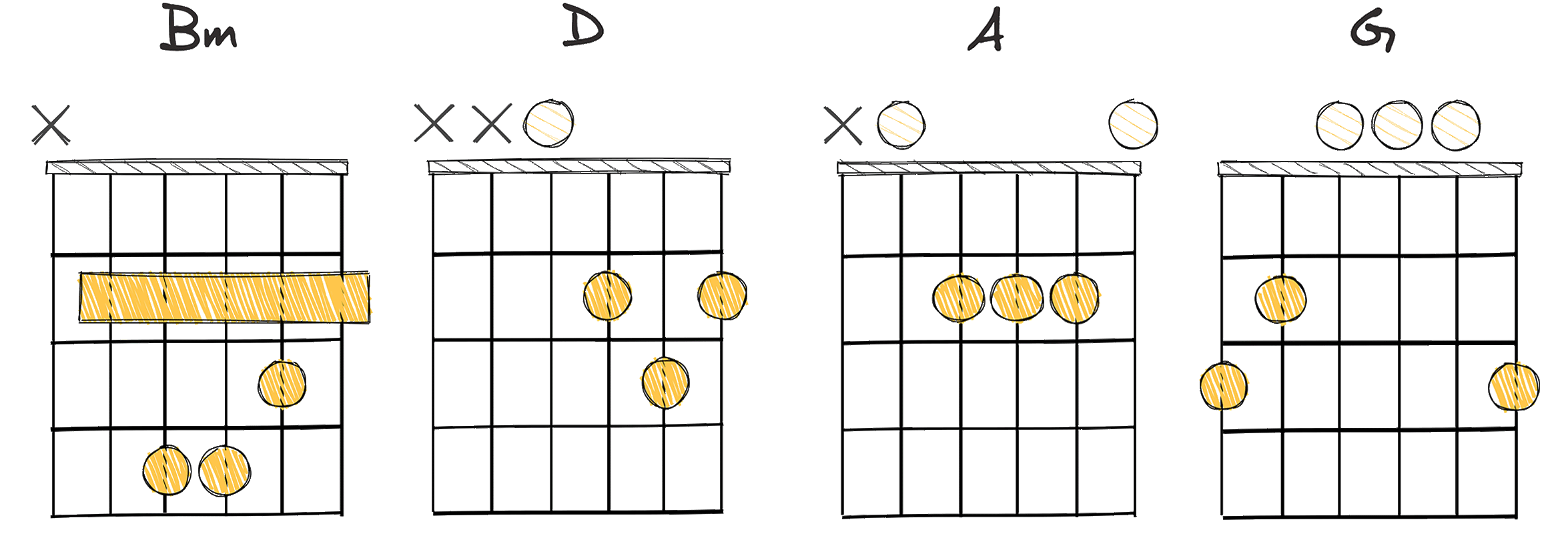
Understanding the intricacies of guitar chord progressions not only allows guitarists to master their current repertoire but also broadens their musical creativity.
The chord progression under discussion, vi-I-V-IV (6-1-5-4), often labeled as the ‘pop progression’, is a favored sequence in modern popular music owing to its musical appeal.
This progression is commonly found across a variety of genres, lending a well-known sound that is pleasing and familiar to listeners’ ears.
Historically, the vi-I-V-IV progression gained significant popularity during the 1950s, resonating with the clean, structured, and relatively simple nature of the pop music of the era.
This chord progression, due to its simplicity and melodious flow, became an essential tool for songwriters to create catchy and pleasing melodies.
Utilizing this progression allowed for the creation of a harmonic structure that was easily identifiable and appealing.
It enabled musicians to move fluidly between chords, providing a strong melodic foundation for their compositions.
The underlying progression bolsters the emotionally charged lyrics with its smooth transitions and recurring rhythm.
The delicate balance between tension and release in this progression amplifies the emotive nature of the song.
The resonance and familiarity of the vi-I-V-IV progression are so strong that even beginner guitarists are likely to recognize it from their favorite songs.
As one might expect, the appeal of this progression extends far beyond its historical significance or its simplicity for beginner players.
The vi-I-V-IV progression is relatively ‘easy to play’, providing an encouraging start for beginners.
Moreover, the popularity of the vi-I-V-IV progression persists as it suits a diversity of musical moods, whether in pop ballads, rock anthems, country hits, or jazz standards.
Ultimately, understanding the vi-I-V-IV progression is an important stepping stone for those seeking to explore the power of music and unlock the potential of their guitar playing ability.
IV-I-IV-V (4-1-4-5)
This IV-I-IV-V progression offers a classic, heartwarming resolution in music.
The IV-I-IV-V chord progression, also known as the 4-1-4-5, is a simple yet powerful sequence common in many popular and classical music genres. It is a staple progression that creates a harmonious flow, adding a classical and timeless feel to your compositions.
- Difficulty: Easy
- Example: Bb – F – Bb – C (Key of F major)
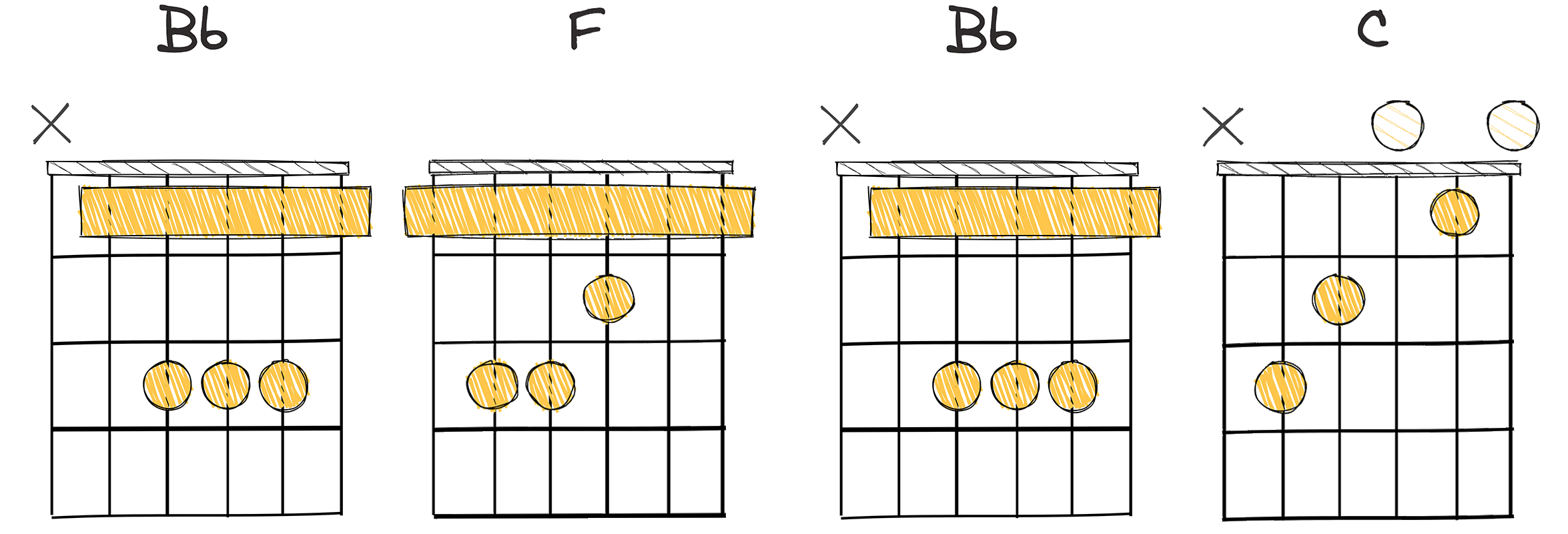
The IV-I-IV-V (4-1-4-5) chord progression is a classic staple in the music world, tracing its roots back to some of rock and roll’s most prominent eras.
It possesses a certain distinct quality of easiness and simplicity, yet provides a depth that has captivated audiences for generations.
Revered as one of the easiest chord progressions to grasp, IV-I-IV-V (4-1-4-5) effectively elevates music by capturing listeners’ attention and emotions.
This harmonic structure allows for a smooth, relaxed melody that artists can easily experiment with, making it a favorite especially among beginners.
This pattern provides a sense of familiarity and warmth, making listeners feel closer to the music and more engaged.
Indeed, the IV-I-IV-V progression executed in this track gives it a timeless appeal, contributing greatly to its sustained popularity over the years.
Translated into chord names within the Key of F Major, Bb would represent the IV-I-IV-V progression Bb – F – Bb – C.
The distinctive structure of IV-I-IV-V, simple in form yet profound in substance, is a testament to the efficacy of minimalism and the paramount importance of harmonic progression in music composition.
Despite its simplicity, the chord progression has a rich history and has remained a mainstay in popular music due to its ability to evoke deep emotions.
It is a valuable tool that every musician can adapt to their craft, whether they are a novice learner picking up their first guitar, or a seasoned composer looking for the right mix of chords to weave their next masterpiece.
Ultimately, it is the potency and accessibility of the IV-I-IV-V chord progression that continues to make it such an endearing and lasting part of our musical landscape.
I-vi-ii-V (1-6-2-5)
A classic, smooth progression perfect for jazz and pop melodies.
The I-vi-ii-V (1-6-2-5) chord progression is a timeless classic often used in jazz and pop music, offering a seamless return to the tonic chord and a beautiful harmonic journey. This progression’s inherent balance and resolution make it a staple in many different genres, helping to elevate the quality and depth of your music compositions and improvisations.
- Difficulty: Intermediate
- Example: D – Bm – Em – A (Key of D major)
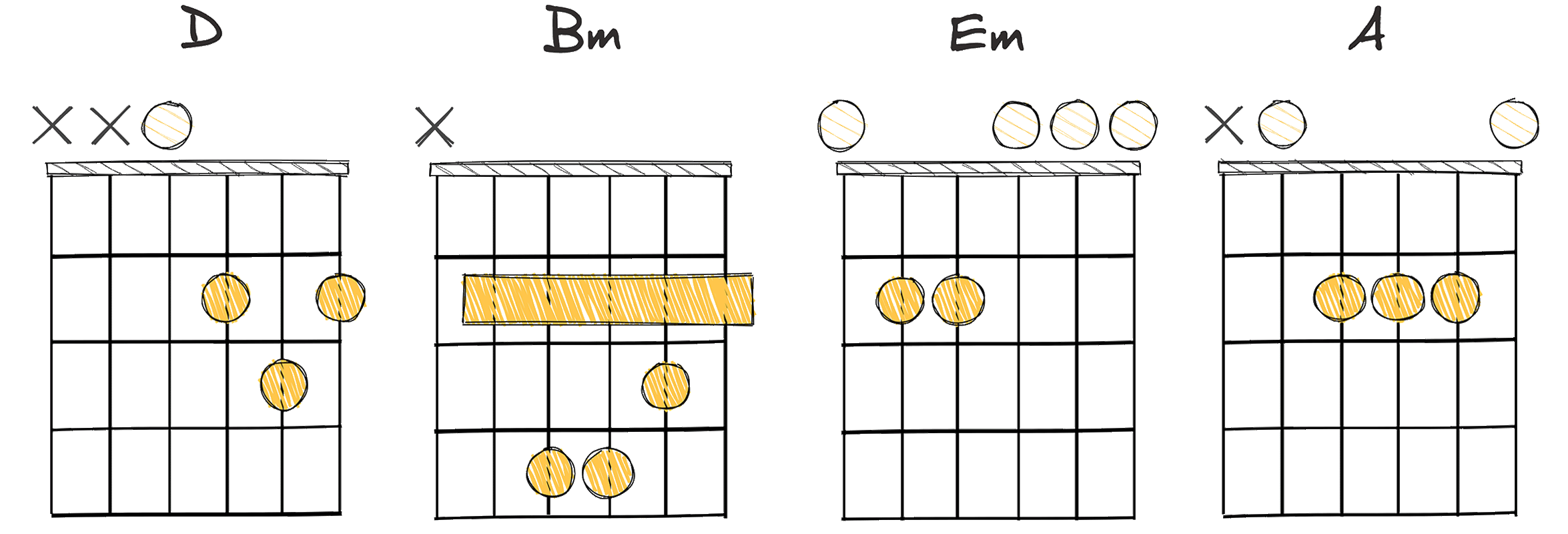
The I-vi-ii-V chord progression, classified as an intermediate level progression, has been a game changer in the music industry.
Originally born out of the world of jazz, it has managed to permeate into multiple genres, notably pop, rock and blues.
For musicians, particularly guitarists, mastering this chord progression is akin to unlocking a vast new world of musical possibilities.
The beauty of the I-vi-ii-V progression lies in its balance between predictability and intrigue—giving enough familiar tones to ground the listener while also providing some unexpected shifts to maintain interest.
In other words, the I-vi-ii-V progression manages to strike a fine balance.
It neither bores the audience with too much predictability nor does it alienate them with excessive experimentation.
Instead, it keeps the listeners engaged, right from the first note to the last, due to its striking harmonic contrast.
Thus, the I-vi-ii-V is not just a chord progression, it is almost a narrative tool, enabling the musician to tell a story that captivates the audience and elevates the music.
I-III-IV-V (1-3-4-5)
A joyful progression infusing an uplifting touch to your tunes.
This chord progression delivers a slightly unconventional sequence that diverges from the standard pop and rock progressions, adding an uplifting, interesting twist to your music. The movement from the tonic (I) to the mediant (III) introduces unexpected brightness, while the transition to the subdominant (IV) and dominant (V) chords adds complexity and depth, resulting in a layered, emotionally resonant sound.
- Difficulty: Easy
- Example: G – B – C – D (Key of G major)
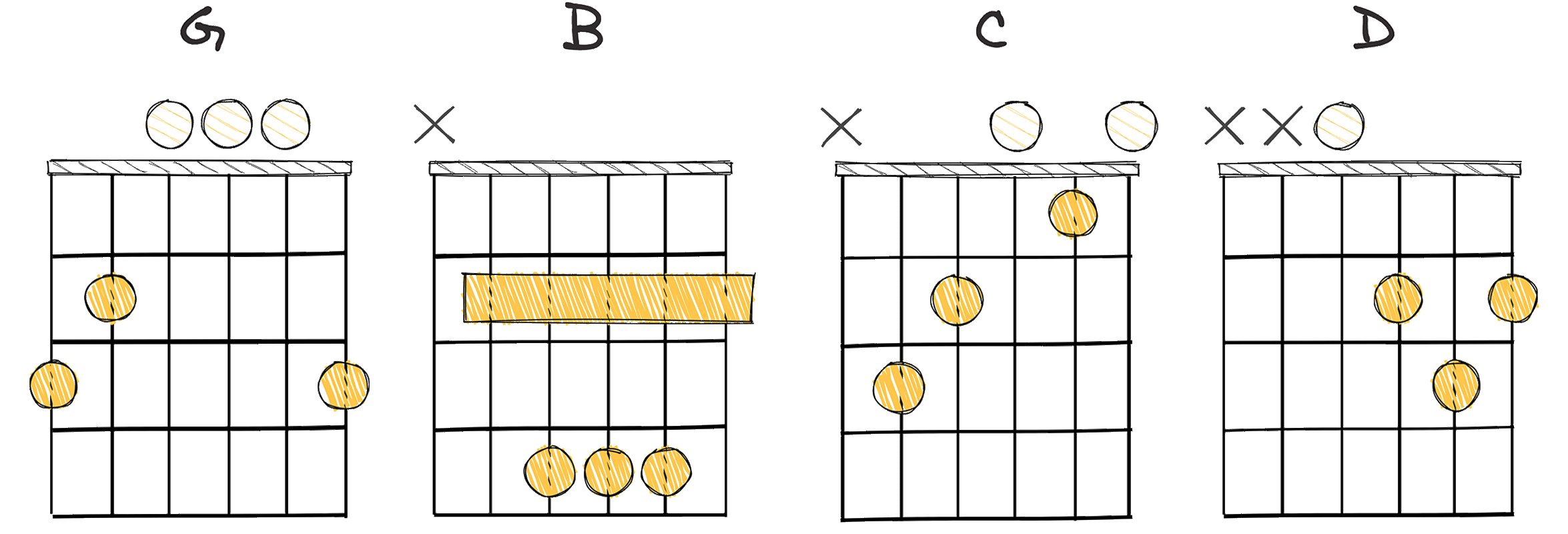
The I-III-IV-V chord progression, often numerically shown as 1-3-4-5, is a widely popular sequence in popular music and songwriting genres.
This progression has a strong foundation in Western music tradition, yet remains a compelling choice for contemporary musicians and songwriters.
Historically speaking, the roots of the I-III-IV-V chord progression can be traced back to classical music.
Throughout centuries, musicians have been utilizing this musical pattern to add structure and consistency to their composition.
Moving to more recent times, the I-III-IV-V chord progression has moved from classical symphonies to rock, pop, country, and blues music.
Its ubiquity can be attributed to its provision of a simple yet powerful framework around which musicians can construct their songs.
The I-III-IV-V chord progression is one of the easier chord progressions to play on guitar.
This attribute may be attributed to the inherent structure and simplicity of the sequence, making it an excellent choice for beginner and intermediate guitarists.
While the chords themselves are relatively simple to play, the unique strumming pattern and the iconic riff that Sting, the band’s frontman, manages to create significantly contributes to the song’s overall feel.
Up-and-coming guitarists love this progression, not only for its historical significance but also for its simplicity and versatility that allows room for creative, unique riffs and improvisations.
This type of guitar chord progression provides an excellent foundation upon which to construct a track.
It is relatively easy to follow, and its natural flow makes it a favorite for guitarists of varying experience levels.
With its roots in classical traditions and its efficacy in modern pop music, the I-III-IV-V progression provides a bridge between the past and the present.
By employing this progression, you can create a sound that is grounded in tradition yet innovative, assisting in the creation of music that resonates deeply with listeners.
To summarize, the I-III-IV-V (1-3-4-5) progression is a prevalent chord sequence in many musical genres and holds its position as a fundamental tool for artists looking to create engaging and memorable tunes.
V-vi-IV-I (5-6-4-1)
A timeless, emotive progression providing depth and resolution to tunes.
The V-vi-IV-I guitar chord progression is a versatile sequence that can add depth and emotional resonance to your compositions. Used in various music genres and typically recognized by its “resolved” sound on the final I chord, this progression creates a dramatic shift of energy, often leading to a satisfying, well-rounded conclusion in a song’s structure.
- Difficulty: Easy
- Example: D – Em – C – G (Key of G major)
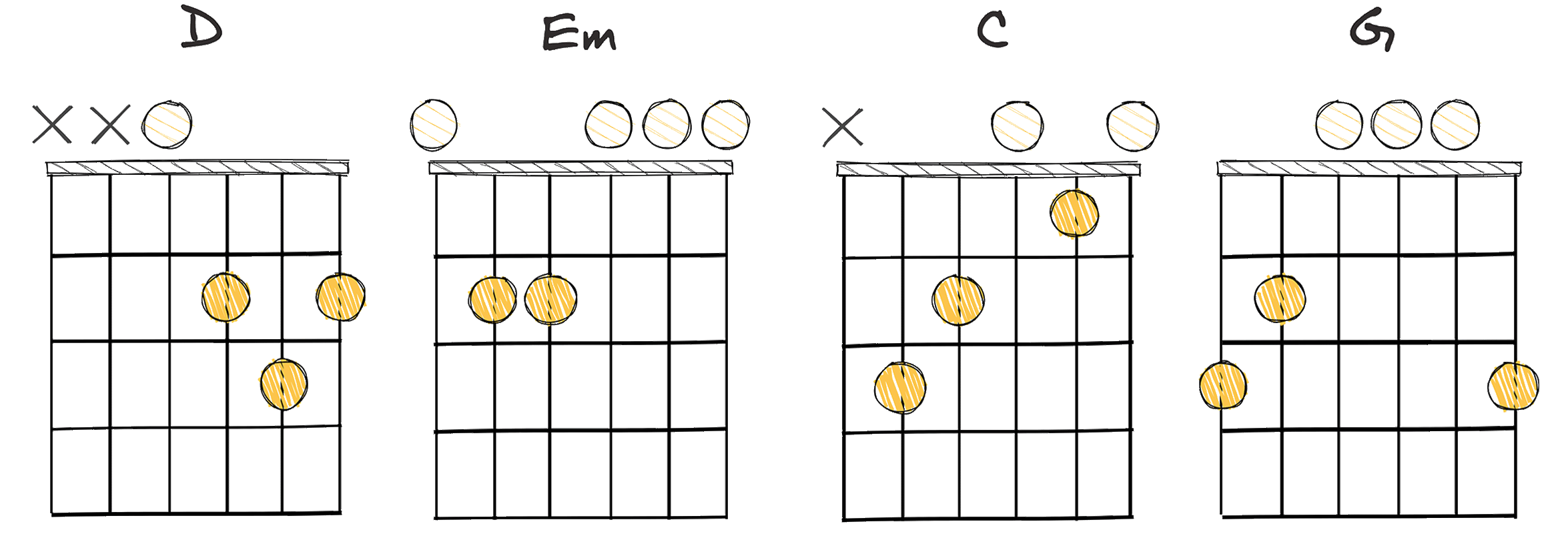
The V-vi-IV-I (5-6-4-1) chord progression is one of the guitar chord progressions that have the potential to substantially elevate your music.
It’s an accessible sequence that is comfortable to perform on the fretboard, allowing you to focus more on the emotionality and dynamism in your performance.
This chord progression has been used in countless timeless songs across various genres, testifying to its versatility and emotional expressivity. It’s a progression that can take a song from simple and catchy to atmospheric and poignant, depending on how you play it.
The V-vi-IV-I progression can infuse a powerful sense of resolve in your song, making it a favorite among songwriters and composers.
The resolve that this progression creates comes from the tension established by the V (major 5) and vi (minor 6) chords, which is then released gracefully when the progression resolves to the I (major 1) chord.
Thus, whether you’re playing a ballad or a rock anthem, this progression can greatly enhance the emotionality of your performance.
The V-vi-IV-I progression is easy to play in the key of G major, with the chords being G (I), Em (vi), C (IV), and D (V).
This is particularly useful for beginners as these are some of the first chords they learn on the guitar.
This progression might be simple, but its potential to add depth and complexity to your music cannot be underestimated.
While the progression has roots in classical music, it has found its way into many modern genres, showcasing its adaptability and timelessness.
The V-vi-IV-I progression, despite its simplicity, packs a punch when it comes to adding emotional depth and sonic variety to your music.
This progression’s ability to traverse the emotional spectrum, its versatility, and its historical significance make it a go-to for many musicians.
From The Beatles to contemporary artists, the V-vi-IV-I chord progression continues to feature prominently in music, proving its timeless appeal and creative potential.
ii-IV-I-V (2-4-1-5)
A soulful progression perfect for creating emotive and powerful tunes.
The ii-IV-I-V chord progression is a powerful sequence renowned for its emotional resonance and musical versatility. This sequence is especially noteworthy for its ability to create tension and suspense when composing a piece, making it a highly favoured choice among musicians across numerous genres.
- Difficulty: Intermediate
- Example: Em – G – D – A (Key of D major)
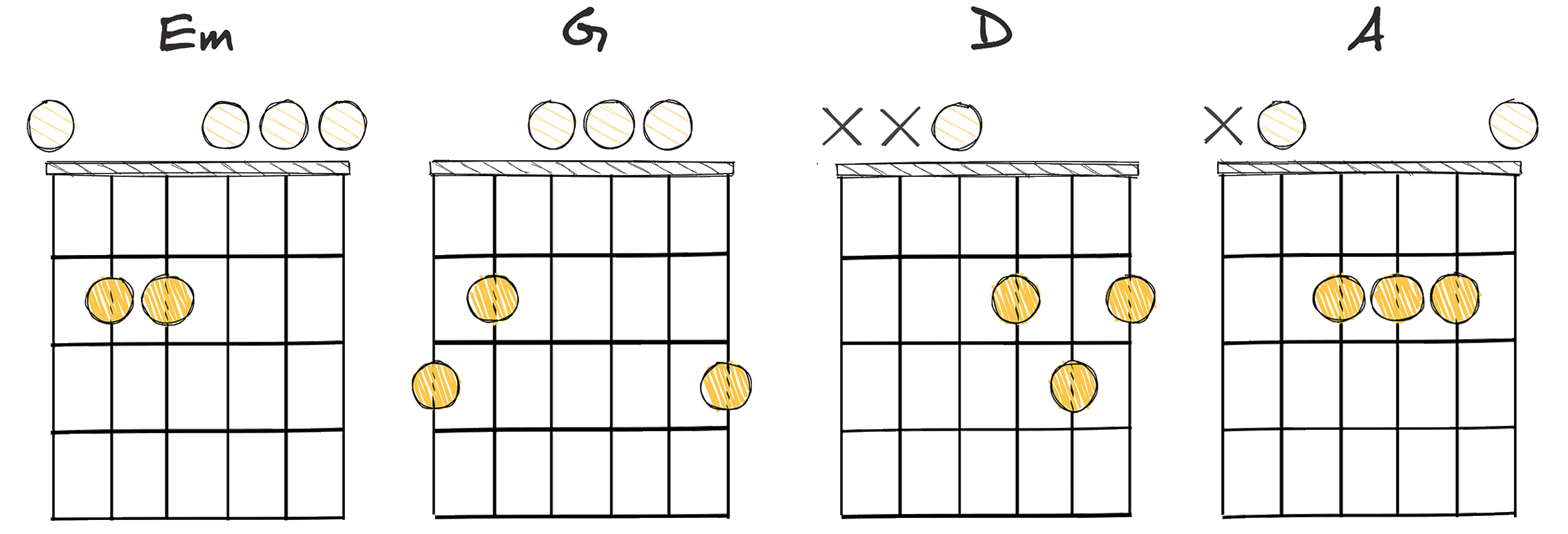
There are a plethora of guitar chord progressions that have defined the sound and feel of music over the years, but one that particularly stands out is the ii-IV-I-V progression (2-4-1-5).
This chord progression is commonly found in various genres of music particularly in jazz, blues, and rock.
It’s considered to be an intermediate level progression due to its use of both major and minor chords, requiring a significant understanding of chord construction and music theory.
With this progression, the emotion and tension it creates brings a unique dynamism and harmony to music.
The ii-IV-I-V progression holds a significant place in music history due to its eminent usage in some of the most renowned songs ever produced.
What sets this progression apart is the way the minor ii chord adds a melancholy touch before resolving to the satisfying major IV chord, followed by the root I chord and the dominant V chord.
Mastering the ii-IV-I-V progression can open up a wide array of opportunities for aspiring musicians, allowing them to explore a broader spectrum of musical possibilities.
While it can pose a challenge at first, with time and practice, its usage can truly elevate a composition and enrich the musical experience.
With deeper understanding and application of such progressions, we only scrape the surface of the endless possibilities guitar chord progressions offer.
The Bottom Line
After reviewing these traditional chord progressions, it’s evident that they provide a solid foundational blueprint for composing and understanding a wide variety of music.
They exhibit the power of structure, predictability, and repetition in crafting memorable melodies and harmonies.
From pop to classical music genres, these progressions’ impact can be observed, further attesting to their universal influence.
Moreover, their varying arrangements and sequences ensure musical diversity, paving the way for unlimited creative possibilities.
Despite their simplicity, these chord progressions serve as a pivotal tool in the art of music composition, underlining the beauty and depth of music theory.
In love with guitars, and gear; expert in all things music! Been writing about guitars for about 5 years and counting. Born in the ’90s. Alma Mater: University of Havana. Always curious, trying to understand the world. #TeamFender




